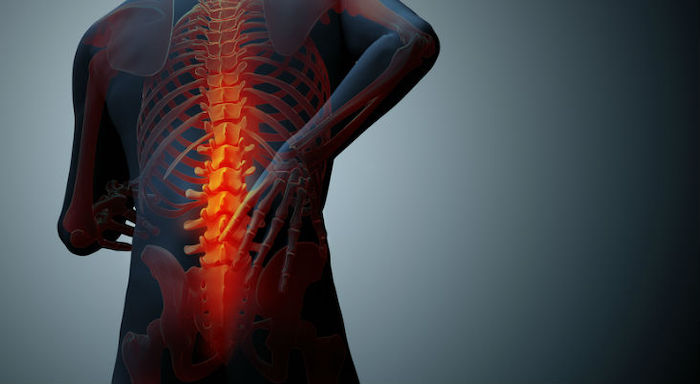
Though degenerative disc disease can cause debilitating neck or back pain which may also radiate into the arm or leg, there are many treatment options. Some treatments may be more beneficial and effective than others based on the individual, so here are several options to consider trying in order to reduce pain.
Take Initial Steps for Pain Control
When degenerative disc pain flares up and spine pain interferes with daily activities, the first step is to get the pain under control. Initial treatments typically include:
- A short period of relative rest, however, remaining as active as possible is preferred.
- Ice and/or heat applied to the affected area for 15-20 minutes every 2 hours as needed; be sure to use a buffer (such as a towel) between the ice/heat pack and the skin to avoid thermal injury.
- Over-the-counter (OTC) acetaminophen (Tylenol) if no there are no contraindications (such as allergy or liver disease).
· Over-the-counter nonsteroidal anti-inflammatory drugs (NSAIDs), such as ibuprofen or naproxen) if there are no contraindications (such as allergy, kidney disease, bleeding ulcers, or concurrent use of anticoagulation medication).
In rare cases when degenerative disc pain persists despite a short period of relative rest, stronger medications may need to be considered, such as prescription pain medications or interventional procedures. This will require formal evaluation by a trained medical professional to determine the diagnosis and treatment course.
Participate In Physical Therapy
Once your pain levels have decreased, it is a good idea to ask your doctor about safe and effective ways to exercise and become more active. Exercise improves blood flow, which in turn can carry healing factors. It also helps to improve muscle strength and stability for better spine support and reduced pain.
A physiatrist, physical therapist, or another qualified medical professional can help design a strengthening and stretching program to meet your specific needs. In addition to reducing pain, strengthening the lower back and abdominal muscles can help improve mobility and function. Keeping the hamstring muscles stretched and loose can also relieve stress on the lower back.
Additionally, a comprehensive physical therapy program may include other pain-relief measures, such as one or more of the following:
- Massage therapy, manual therapy, and/or myofascial release
- Transcutaneous electrical nerve stimulation (TENS)
- Spinal mobilization
Low-impact aerobic exercise can also be beneficial for heart health, strengthening your back, and boosting your mood. Consider walking, exercise biking, an elliptical machine, or water therapy. Staying active even after pain resolves is the key to long-term success.
Make Everyday Lifestyle Changes
Subtle changes in your daily routine can add up to significant pain relief for those with degenerative disc disease.
Modify Or Stop Activities That Hurt Your Back
It may be hard to give up the Saturday basketball game or scale back on golf, but doing so may minimize twisting of the back. The same goes for lifting large or heavy objects.
In general, avoid or minimize any activities that make your back feel worse.
Support your back throughout the day.
While sitting tends to put more stress on the spine, an ergonomic chair may help. When you sit, keep your ears above your shoulders (not slouched) and have lumbar support to maintain your natural lumbar curve. In addition, many people find it helpful to work at a standup desk for at least part of the day. Proper ergonomic setup of the workstation is key to keeping the spine naturally aligned.
Changing how you sleep, using different pillows, and/or considering a new mattress can help provide better spinal alignment and support throughout the night. If you find that you're most comfortable in a recliner, consider sleeping in a semi-upright position with an adjustable bed, or simply by adding a foam-wedge pillow to your regular bed.
Consider Interventional Options If Pain Persists Despite Conservative Treatments
While degenerative disc pain can typically be managed with conservative treatment, sometimes interventional procedures, such as injections, may assist with pain relief. It is reasonable to consult with an interventional pain management physician to discuss interventional options in the form of injections. Some injections can be diagnostic, therapeutic, or both. They may also consider ordering diagnostic studies such as x-rays, MRI, or EMG/NCS to further evaluate the problem.
When non-surgical treatments fail, surgery may need to be considered in cases where:
- Impingement on a spinal nerve is identified by diagnostic studies and/or injections.
- Worsening numbness, tingling, and/or weakness.
- Pain that significantly interferes with quality of life and daily activities despite trying nonsurgical treatments for 6 to 12 weeks.
- Loss of bowel or bladder control.
Surgery for degenerative disc pain involves decompressing the painful spinal nerve while maintaining spine stability. Various surgical options are available depending on the specific situation, such as a lumbar discectomy (which involves removing all or part of a degenerative disc) and/or spinal fusion surgery.
Most commonly, the final decision to have surgery for degenerative disc disease is up to the patient. Before opting for major spine surgery, be sure to ask the surgeon (neurosurgeon or orthopedic surgeon) about the surgery’s potential risks and benefits, as well as any alternative treatment options. If the surgeon has not answered all of your questions to your satisfaction, seek a second opinion.
As with any medical condition, proper diagnosis and treatment by a trained medical provider are key. Thankfully, the vast majority of degenerative disc disease pain will resolve with conservative (nonsurgical) treatment.
Precision Pain Care and Rehabilitation has two convenient locations in Richmond Hill – Queens and New Hyde Park – Long Island. Call the Richmond Hill office at (718) 215-1888, or (516) 419-4480 for the Long Island office, to arrange an appointment with our Interventional Pain Management Specialist, Dr. Jeffrey Chacko.













